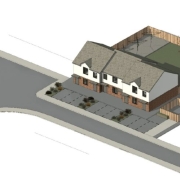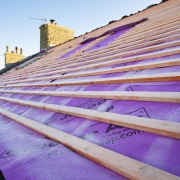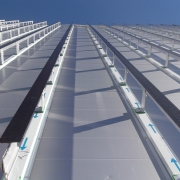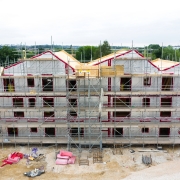Established in 1939, O’Reilly Precast has evolved from a modest family enterprise into a paragon of innovation in the precast concrete industry across Ireland and the UK. Through decades of dedication, we have pioneered advancements that have not only transformed our operations but also the broader construction sector. Our journey is a testament to our commitment to excellence, innovation, and sustainability, setting new benchmarks in construction methodologies.
The Smart Choice: Offsite Construction
In an era where precision, efficiency, and sustainability dictate construction practices, offsite construction emerges as the smart choice for forward-thinking companies.
O’Reilly Precast is at the vanguard, harnessing advanced technologies such as Building Information Modeling (BIM) to ensure unmatched design accuracy in precast elements. This innovative approach aligns with the UK government’s preference for offsite manufacturing in publicly funded projects, highlighting its significance in modern construction. Offsite construction minimises waste and maximises resource efficiency, significantly reducing carbon emissions by limiting site disturbance and vehicle movement, thus embodying the principles of sustainable development.
Accelerating Construction: The Offsite Advantage
The adoption of offsite construction methods by O’Reilly Precast signifies a leap towards accelerating construction processes without compromising quality or safety. By allowing simultaneous progress in construction activities and site preparation, offsite construction ensures that projects are resilient to weather-related delays, thanks to the controlled factory environment. This method excels in expediting repetitive designs and ensures a predictable schedule, as precast elements arrive on-site ready for immediate installation. Such streamlined workflows eliminate common inefficiencies associated with onsite construction, offering a predictability that is invaluable in today’s fast-paced construction landscape.
Health & Safety: Our Foremost Priority
At O’Reilly Precast, the health and safety of our workforce and the broader community are paramount. Offsite construction significantly enhances safety standards by shifting the bulk of construction activities to a controlled factory setting. This transition reduces the risks posed by adverse weather and changing site conditions, leading to a notable decrease in on-site accidents. Furthermore, the precise offsite production of precast components minimises structural faults, while the reduced need for on-site workers lowers the incidence of accidents. The decrease in noise and dust pollution contributes to safer and healthier working conditions, underscoring our commitment to not only meeting but exceeding health and safety regulations.
Dispelling Myths: The Truth About Precast Construction
Precast construction is often enveloped in myths that obscure its true value and potential. At O’Reilly Precast, we’re committed to debunking these misconceptions, illuminating the versatility, efficiency, and sustainability of precast concrete.
Myth 1: Precast Concrete is Prohibitively Expensive
One of the most persistent myths is that precast concrete incurs higher costs than traditional construction methods. While the upfront investment in precast elements might be higher due to the precision engineering and quality control processes, the overall project costs are often lower. This efficiency comes from reduced construction timelines, minimised need for onsite labour, and lower long-term maintenance costs. Precast construction offers a cost-effective solution when considering the lifecycle costs of a building, providing value that far exceeds initial investment.
Myth 2: Limited Design Flexibility
Another common misconception is that precast concrete stifles architectural creativity. On the contrary, modern precast technology is incredibly versatile, allowing for a wide range of architectural styles and finishes. From intricate textures and colours to unique shapes and sizes, precast concrete can be customised to meet any design aesthetic.
This flexibility empowers architects and designers to explore creative solutions without the constraints often associated with traditional materials.
Myth 3: Logistical Nightmares
The logistics of transporting and installing large precast elements can seem daunting, leading to the belief that precast construction complicates project management.
However, with proper planning and coordination, these challenges are easily navigated. O’Reilly Precast’s Just-In-Time Delivery System exemplifies how logistical hurdles can be overcome. By staging deliveries to align with the construction schedule and utilising specialised transportation and lifting equipment, we ensure that precast elements arrive just as they are needed, streamlining the construction process and reducing site congestion.
Myth 4: Precast is Only for Industrial or Utilitarian Buildings
There’s a misconception that precast concrete is only suitable for industrial buildings or structures where aesthetics are a secondary concern. This couldn’t be further from the truth. Precast concrete is used in a variety of building types, including residential homes, schools, hospitals, and high-end commercial spaces. The material’s adaptability allows for a range of architectural expressions, from the sleek and modern to the ornate and classical. Precast concrete offers a blend of functionality and aesthetic appeal that can enhance any building project.
Myth 5: Environmental Unfriendliness
Some believe that concrete, as a construction material, is inherently unsustainable. However, precast concrete, when compared to other construction methods, offers significant environmental advantages. The controlled factory setting of precast production allows for more efficient use of materials and reduces waste. The durability and longevity of precast structures also contribute to their sustainability, as they require less repair and maintenance over their lifecycle. Additionally, the thermal mass properties of concrete contribute to energy efficiency in buildings, reducing heating and cooling costs.
Strategic Precast Implementation at Heathrow Airport Project Overview
Tasked with a significant undertaking, the main contractor, Grove Developments, alongside O’Reilly Precast faced the challenge head-on: constructing a 14-story hotel within the confines of Heathrow Airport’s bustling environment. This venture required not only technical expertise but also a mastery of logistics and safety regulations
Precast Execution
- Scope: The project called for 13,000 m² each of Hollowcore floors and Screed, 12,500 m² of Precast Walls, and 80 flights of Stairs and Landings.
- Location: A stone’s throw from Terminal 2, placing it at the heart of one of the busiest travel hubs globally.
Navigating Complexities
- Intricate Logistics: The challenge of manoeuvring materials through the busy terminals was met with robust planning, ensuring smooth delivery and installation with minimal disruption to the airport’s operations.
- Elevated Safety Standards: In an area where security is paramount, the team implemented a comprehensive online induction programme for all site workers, enhancing on-site safety knowledge and compliance with airport regulations.
- Collaborative Precision: The project necessitated a high degree of coordination with various stakeholders, executed through clear communication channels and precise timing to fit the airport’s strict operational windows.
- Advanced Installation Techniques: The use of state-of-the-art safety systems facilitated the secure and efficient assembly of precast elements, showcasing the potential for precision in complex environments.
Outcomes and Impact
The completion of the hotel’s precast structure demonstrates the viability of offsite construction methods in high-stakes scenarios. It stands as a benchmark for delivering complex projects with rigorous demands for energy efficiency, durability, and architectural integrity. The strategic use of Hollowcore floors, Precast Walls, and Stairs enabled a rapid, safe, and efficient build, setting a precedent for future projects within the sector.
Implications for Construction Professionals
This case exemplifies how integrating offsite construction techniques can offer substantial benefits, including adherence to tight schedules, impeccable safety standards, and logistical efficiency. For industry professionals, the project is a clear indicator that with the right planning and expertise, offsite construction can deliver superior results, even under stringent conditions.
The Practical Advancements of Precast Concrete
O’Reilly Precast is dedicated to advancing the understanding and application of precast concrete. By addressing the prevalent myths, we strive to showcase the substantial, tangible benefits of precast construction. Our focus on innovation, customer satisfaction, and sustainability is central to our approach, driving us to refine what precast concrete can deliver. As the construction sector progresses, we are proud to offer precast solutions that often surpass the performance of traditional methods.
The evolution of O’Reilly Precast reflects our continuous commitment to quality and sustainable practices. With a strategic approach to offsite construction and ongoing enhancement of our precast technologies, we are well-placed to address the demands of today’s construction challenges.
Looking to the future, O’Reilly Precast will continue to embrace the changes shaping our industry, maintaining a strong focus on delivering practical and efficient building solutions.
Invitation to Collaborate
We invite the construction community to explore the benefits of offsite precast construction with O’Reilly Precast. Whether you seek efficient, sustainable construction methods or innovative design solutions, we are here to support your project’s success. Reach out to us at
sales@oreillyprecast.co.uk to discover how our expertise can transform your construction journey.
O’Reilly Precast: A Precast Revolution – Smarter, Faster, Safer.
www.oreillyprecast.com











